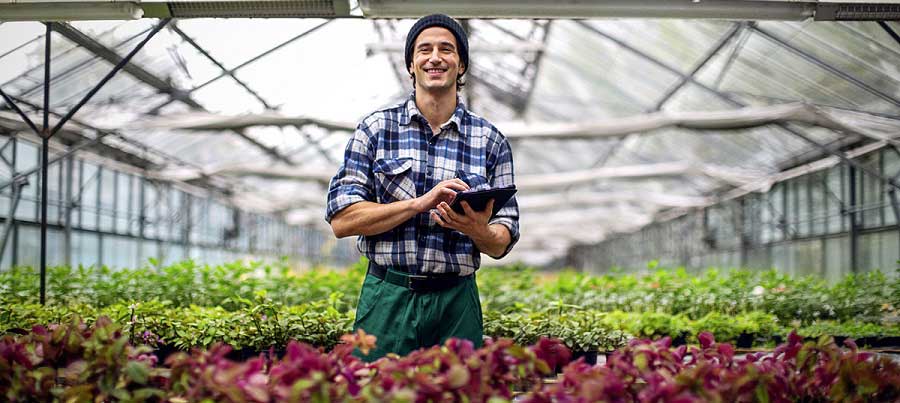Are you keeping up with the latest in agritech?
26 Jul 2021
New Zealand has a really strong history, reputation, and heritage in agrictulture and primary industries and an emerging technology industry that’s going from strength to strength. Tim Wixon, Head of Technology Industry, thinks it’s a great combination to create and grow global agritech businesses, which use or create unique technologies and combinations of existing technologies. Read on to find out more from Tim.
Current trends
The World Resources Institute predicts by 2050 the population will reach 10 billion with an extra 2.5 billion people living in cities (assuming they’re not underwater by rising sea levels…). This means the planet will need 56% more food without using more land, all while lowering emissions.
It sounds like an almost impossible task!
At the recent Fieldays event in Mystery Creek and from recent travels around New Zealand, it’s been really encouraging to see innovative and sustainability focused agritech businesses determined on making this more achievable for the farming, horticulture, apiculture, and aquaculture industries. Their solutions? Technology. Using or creating technology to improve yields, operate smarter, create plant-based alternatives to meat, breed more resilient crops, improve quality, track environmental impacts, and implement sustainable practices to protect the land – with the opportunity to set a strong example globally from New Zealand.
The scalability of technology business models from New Zealand make them a great vehicle for global impact for the better.
Agritech and how it works
A whole new industry is growing up around agritech here. We’re strong already and have an amazing story to tell the world, for example:
- HawkEye, Ravensdown’s map-based software, solves the old process of using paper copies of maps to see where fertiliser is being directed, manually calculating the quantity required, then phoning Ravensdown to order the product and making another phone call to the spreading company. Now farmers access this information automatically in real-time and the order is placed by the tech.
- cropx has a proprietary soil sensor to manage irrigation and fertilization. The sensor helps farmers know when a plant hasn’t received enough water before the plant does, and sends crop-specific recommendations and alerts to the farmer of any potential risks from pests or diseases.
- Robotics Plus help mechanise on-orchard and horticultural tasks to reduce reliance on seasonal and migrant labour forces. Their kiwifruit harvester, quadbike-based pollination system, and apple packer with inbuilt electronics and vision system all lower costs and increase capacity on the same land area.
- Halter HQ has solar-powered, GPS-enabled smart collars fitted to dairy cows, allowing farmers to remotely shift, virtually fence, and monitor their cow’s health, feed, and behaviour. No more walking behind cows. A press of a button will bring any mob to the shed, feed pad or shift them to graze a new break.
Another example is drone farming to improve yields. Some farmers are using drones to monitor crops more frequently and intervene remotely, analyse plant health, track livestock, determine nutrient deficiencies, identify pest damage to plants, match fertilizer requirements, check water quality, spot any plant diseases, and determine the mineral and chemical composition of the soil. In the past you’d rely on walking around the farm with a keen eye. Now it’s from your phone and a mini helicopter in the sky.
All these agritech businesses take advantage of the internet of things and clever software, where collected data from the likes of sensors and agricultural machinery is combined into meaningful information to help give options on how you operate, and give you more real time information to make decisions all at your fingertips.
The good news is that the app and software selection increases every year, and it’ll get cheaper and better. There is a growing multitude of sensors and software to enable tracking most things you may wish to. And that’s just the start.
The benefits of adopting agritech
There are of course macro benefits for focusing on agritech, such as building New Zealand’s global problem solving reputation, preserving the environment, being socially responsible for the next generations, and more high value exports.
But there are also micro benefits for the person or business, for example:
- reduction in food loss and waste
- increase in livestock and pasture productivity
- improved water and soil quality
- adaptation to climate change
- improved fisheries management
- reduced greenhouse gas emissions.
All of these benefits flow down to more profit per hectare or other inputs, less work, and encourages land, air, and sea use longevity. The trick will be working out what range of technologies to use and what is actually important to measure.
Within New Zealand, the technology available for the wider agriculture industry is changing quickly too. It’s not only the availability, but the efficacy and ever reducing costs of purchasing and utilising those technologies that is exciting. There are some great examples of earlier adopters around New Zealand who demonstrate what is possible.
What we still need to do
There’s always more to do, and we have another unique advantage here in New Zealand. The close proximity and accessibilty of central government, government departments, universities, agri businesses, tech companies, sources of capital, banks, and others working with the agri sector is unlike other nations. This competitive advantage could be key for prototyping ideas and growing an increasing number of global agritech businesses out of the New Zealand ecosystem.
But to maintain the momentum and keep pushing New Zealand ahead, I think we also need:
- a bias towards commercialising the research coming out of Crown Institutes and Universities, rather than publishing only
- to use these opportunities to create new business models, test, and learn
- to accept NZ is the ultimate testing ground for agritech businesses to start, and therefore encourage collaboration
- to take bigger bets on businesses that could scale up and be a global leader
- to grow those agritech businesses who can sell their IP globally.
The agritech ecosystem
If you need help or want more information, connect with the agritech ecosystem. A great summary on page 15 of the TIN Agritech Insights Report outlines all the government, research, funding, support networks, and international experts you can tap into. Some examples include Agritech New Zealand, your levy group such as Beef+Lamb, DairyNZ, and HortNZ, any university involved in agritech like Lincoln University, and the government departments (Ministry for Primary Industries, and Callaghan Innovation). Finally, don’t forget your agri banker. They have an extensive network of who is best to help.
To conclude
I’m hugely opimitistic about the future for agritech in New Zealand to help us be more efficient and sustainable. We can not only improve how the future of agri looks here in NZ, but could well change the global agri industry for the better too.
Any views expressed in this article are the personal views of Tim Wixon and do not necessarily represent the views of BNZ, or its related entities. This article is solely for information purposes and is not intended to be financial advice. If you need help, please contact BNZ or your financial adviser. Neither BNZ nor any person involved in this article accepts any liability for any direct or indirect loss or damage arising out of the use of, or reliance on, all or any part of the content.
References to third party websites are provided for your convenience only and BNZ accepts no responsibility for the availability or content of such websites.



